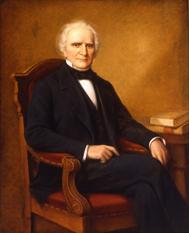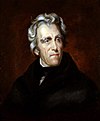This article has multiple issues. Please help improve it or discuss these issues on the talk page. (Learn how and when to remove these messages)
|
| Samuel D. Ingham | |
|---|---|
 1893 posthumous portrait of Ingham, by Henry Ulke 1893 posthumous portrait of Ingham, by Henry Ulke | |
| 9th United States Secretary of the Treasury | |
| In office March 6, 1829 – June 20, 1831 | |
| President | Andrew Jackson |
| Preceded by | Richard Rush |
| Succeeded by | Louis McLane |
| Member of the U.S. House of Representatives from Pennsylvania's 8th district | |
| In office March 4, 1823 – March 4, 1829 Seat B | |
| Preceded by | Seat established |
| Succeeded by | Peter Ihrie Jr. |
| Member of the U.S. House of Representatives from Pennsylvania's 6th district | |
| In office March 4, 1813 – July 6, 1818 Seat A | |
| Preceded by | William Crawford |
| Succeeded by | Samuel Moore |
| In office October 7, 1822 – March 3, 1823 Seat A | |
| Preceded by | Samuel Moore |
| Succeeded by | Robert Harris |
| Personal details | |
| Born | Samuel Delucenna Ingham (1779-09-16)September 16, 1779 New Hope, Pennsylvania, U.S. |
| Died | June 5, 1860(1860-06-05) (aged 80) Trenton, New Jersey, U.S. |
| Political party | Democratic-Republican (Before 1825) Democratic (1825–1860) |
| Spouse(s) | Rebecca Dodd Deborah Hall |
Samuel Delucenna Ingham (September 16, 1779 – June 5, 1860) was an American politician who served as a U.S. Representative and the U.S. Treasury Secretary under President Andrew Jackson.
Early life and education
Ingham was born in New Hope, Pennsylvania, on September 16, 1779. His parents were Dr. Jonathan Ingham, "a famous physician from Philadelphia", and his wife, the former Ann Welding.
After a pursuit of classical studies, he was an apprentice to a paper maker along Pennypack Creek, not far from Philadelphia.
Manufacturer
After completing his apprenticeship, Ingham became the manager of a paper mill at Bloomfield, New Jersey. It was while here he met Rebecca Dodd, whom he married in 1800. They had five children.
Also in 1800, Ingham returned to Pennsylvania and established a paper mill on his mother's farm (his father having died in 1793) that would be his main source of employment in the coming years.
Political career

He was a member of the Pennsylvania House of Representatives from 1806 to 1808. Then, Ingham was appointed Justice of the Peace by the Governor of Pennsylvania.
He was a member of the United States House of Representatives from 1813 to July 6, 1818. He easily trounced his Federalist opponents in the first two elections and had no opposition at all in 1816. He resigned from Congress in 1818 because of his wife's ill health. He was appointed the Prothonotary (Chief Clerk, Notary and Registrar of the Court) of the Court of Common Pleas of Bucks County, Pennsylvania, after leaving Congress. In 1819 Rebecca Dodd Ingham died.
Ingham served as Secretary of the Commonwealth of Pennsylvania from 1819 to 1820.
In 1822, Ingham married Deborah Hall of Salem, New Jersey. They would become the parents of three children.
Also in 1822, Ingham was elected to Congress where he would serve until 1829.
During the 13th Congress he was chair of the United States House Committee on Pensions and Revolutionary War Claims. During the 14th, 15th, 19th and 20th Congresses, he was chair of the House Committee on the Post Office and Post Roads, and he was chair of the House Committee on Expenditures in the Post Office Department during the 15th Congress.
Secretary of the Treasury
Ingham served as the ninth Secretary of the US Treasury from March 6, 1829, to June 21, 1831.
The Second Bank of the United States, viewed by Jackson and much of the nation as an unconstitutional and dangerous monopoly, was Ingham's primary concern as Secretary of the Treasury. Jackson mistrusted the Second Bank of the United States and all other banks.
Jackson thought that there should be no paper currency in circulation but only coins and that the US Constitution was designed to expel paper currency from the monetary system. Ingham believed in the Second Bank and attempted to resolve conflicts between Jackson, who wanted it destroyed, and the Bank's president, Nicholas Biddle.
Despite being unable to reach any resolution between Jackson and Biddle, Ingham left office over an unrelated incident, which stemmed from his involvement in the social ostracism of Peggy Eaton, the wife of Secretary of War John H. Eaton, by a group of Cabinet members and their wives. It was led by Floride Calhoun, the wife of Vice President John C. Calhoun and became known as the Petticoat affair. Eaton challenged Ingham to a duel, which Ingham did not accept. On June 20, 1831, Eaton recruited a posse to search for Ingham, and Ingham responded by arming himself and requesting Jackson's help. With no help forthcoming from the president, Ingham fled to Baltimore the following morning and then to Bucks County, thus likely saving his life.
Societies
During the 1820s, Ingham was a member of the prestigious Columbian Institute for the Promotion of Arts and Sciences, which counted among its members two eventual presidents, Andrew Jackson and John Quincy Adams, and many other prominent men of the day, including well-known representatives of the military, government service, medical, and other professions. In 1840, Ingham was elected as a member to the American Philosophical Society.
Later life
After resigning as Secretary of the Treasury, Ingham resumed the manufacture of paper, and engaged in the development of anthracite coal fields. He was involved with the organization of the Beaver Meadow Railroad Company (e. 1830), of which he was then made president for a time. He was connected with the organization of the Hazleton Coal Company. He worked to promote canals such at the Lehigh Navigation and the Delaware Canal. He moved to Trenton, New Jersey, in 1849, where he worked with that city's Mechanics Bank.
Ingham died on June 5, 1860, in Trenton, New Jersey, at the age of 80, and is interred in the Solebury Presbyterian Churchyard, Solebury, Pennsylvania. Ingham County, Michigan, one of several Cabinet counties named for members of Jackson's administration, is named in Ingham's honor; the city of Lansing, mostly situated in Ingham County, would later become Michigan's capital and center of its third-largest metropolitan area. Ingham Avenue in Trenton, NJ is also named in his honor.
Notes
- The most common name, Beaver Meadow Railroad was in fact, formally incorporated as the Beaver Meadow Railroad and Coal Company.
References
- "Indian Place Names in Bucks County" (PDF). Lenape Nation – A Tribal Community. Archived from the original (PDF) on August 10, 2014. Retrieved September 27, 2012.
- Ford Stevens Ceasar, The Bicentennial History of Ingham County, Michigan (Ann Arbor: Shaw-Barton, 1976), p. 1
- Ceasar, History of Ingham County, p. 1
- Ceasar, History of Ingham County, p. 2
- Caesar, History of Ingham County, p. 3
- ^ "Samuel D. Ingham (1829–1831)". US Treasury Department. November 11, 2010. Retrieved October 28, 2017.
 This article incorporates text from this source, which is in the public domain.
This article incorporates text from this source, which is in the public domain.
- Meacham, Jon (2008). American Lion:Andrew Jackson in the White House. Random House Trade Paperbacks. pp. 179-181. ISBN 978-0812973464.
- Rathbun, Richard (1904). The Columbian institute for the promotion of arts and sciences: A Washington Society of 1816–1838. Bulletin of the United States National Museum, October 18, 1917. Retrieved June 20, 2010.
- "APS Member History". search.amphilsoc.org. Retrieved April 9, 2021.
- The Hopkin Thomas Project (reprinted web excerpts) (1873). "GUIDE-BOOK OF THE LEHIGH VALLEY RAILROAD". a history of the company from its first organization and interesting facts concerning the origin and growth of the coal and iron trade in the Lehigh and Wyoming Region., J.B. Lippincott & Co., Philadelphia.
{{cite journal}}: Cite journal requires|journal=(help) - John S. Koehler, Historian, Weatherly, Pa. (February 17, 1984). "Beaver Meadow Railroad Blazed Trails for Coal". The Hopkin Thomas Project, Timelines Industrial America (Railroad Portraits, Beaver Meadow Railroad). Retrieved August 12, 2016.
{{cite journal}}: CS1 maint: multiple names: authors list (link) - Scott W. Fausti. "Samuel Delucenna Ingham". The Hopkin Thomas Project (Genealogy Portraits, Rev July 2010). Retrieved August 12, 2016.
- Ceasar, History of Ingham County, p. 4
- "Trenton Historical Society, New Jersey".
- United States Congress. "Samuel D. Ingham (id: I000022)". Biographical Directory of the United States Congress.
Further reading
- Remini, Robert V. (1967). Andrew Jackson and the Bank War. New York: W. W. Norton & Company. pp. 52–59. ISBN 978-0393097573.
- Remini, Robert V. (1991). Henry Clay: Statesman for the Union. New York: W. W. Norton & Company. pp. 267–340. ISBN 978-0393030044.
- Kahan, Paul (2016). The Bank War: Andrew Jackson, Nicholas Biddle, and the Fight for American Finance. Yardley, PA: Westholme Publishing. pp. 63–84. ISBN 978-1594162343.
External links
- Finding aid to the Samuel D. Ingham correspondence at the University of Pennsylvania Libraries
| U.S. House of Representatives | ||
|---|---|---|
| Preceded byWilliam Crawford | Member of the U.S. House of Representatives from Pennsylvania's 6th congressional district Seat A 1813–1818 Served alongside: Robert Brown, Thomas Rogers |
Succeeded bySamuel Moore |
| Preceded byJohn Rhea | Chair of the House Post Office Committee 1815–1818 |
Succeeded byArthur Livermore |
| Preceded bySamuel Moore | Member of the U.S. House of Representatives from Pennsylvania's 6th congressional district Seat A 1822–1823 Served alongside: Thomas Rogers |
Succeeded byRobert Harris Single seat |
| New seat | Member of the U.S. House of Representatives from Pennsylvania's 8th congressional district 1823–1829 Served alongside: Thomas Rogers, George Wolf |
Succeeded byPeter Ihrie Jr. |
| Preceded byJohn Telemachus Johnson | Chair of the House Post Office Committee 1825–1828 |
Succeeded bySamuel McKean |
| Political offices | ||
| Preceded byRichard Rush | United States Secretary of the Treasury 1829–1831 |
Succeeded byLouis McLane |
| Chairs of the United States House Committee on Post Office and Civil Service | ||
|---|---|---|
| Post Office and Post Roads (1808–1947) |
|  |
| (Reform in the) Civil Service* (1893–1947) | ||
| Post Office and Civil Service (1947–1995) | ||
| Note | Name shortened from Reform in the Civil Service to Civil Service in 1925. | |
| Cabinet of President Andrew Jackson (1829–1837) | ||
|---|---|---|
| Secretary of State |
|  |
| Secretary of the Treasury |
| |
| Secretary of War |
| |
| Attorney General |
| |
| Postmaster General |
| |
| Secretary of the Navy |
| |
- 1779 births
- 1860 deaths
- United States secretaries of the treasury
- Democratic Party members of the Pennsylvania House of Representatives
- Papermakers
- Politicians from Bucks County, Pennsylvania
- Politicians from Trenton, New Jersey
- Secretaries of the Commonwealth of Pennsylvania
- Jackson administration cabinet members
- Democratic-Republican Party members of the United States House of Representatives from Pennsylvania
- 19th-century members of the United States House of Representatives
